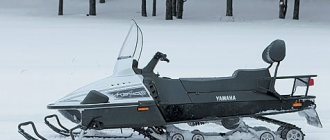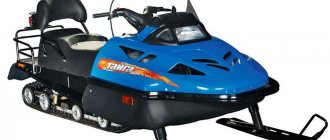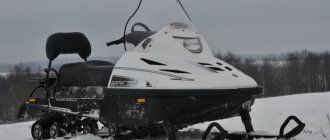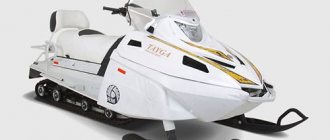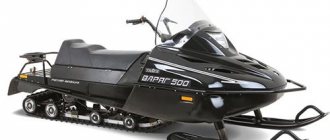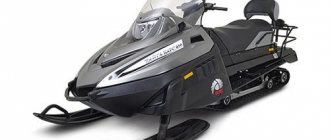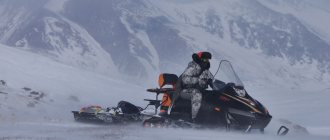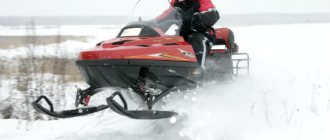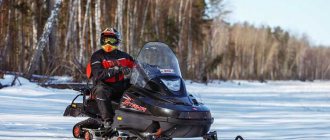"TAIGA" is one of the most common utilitarian and multifunctional snowmobiles in Russia. They started producing it in 1997. With it you can simply, comfortably and reliably get to the desired point, through the least snowy centers of Russia or through the snow-covered tundra.
In this technique, the main thing is not speed, but reliable riding in any harsh places. It gained its trust and reliability after some models were put into service with the Russian army. The Taiga brand has many models in its assortment.
Double: “Varyag”, “TAYGA PATRUL”.
Light single-seat: “RYBINKA”, “TIKSY 250”.
All models with different characteristics, build quality and reliability. And those who know about these snowmobiles first-hand will tell you about all this.
Snowmobile Taiga - owner reviews
“I’ll say right away that the impressions of the Taiga snowmobile are not pleasant. I first met him on a weekend trip with my family and friends. Previously I tried the Buran model and was also not satisfied with its single-lane design. Always falls to the side. Because of this, from the beginning I asked the organizers of the race what kind of snowmobile I would have, and they offered me a two-lane “Taiga”, and I agreed. Due to its powerful engine, it reached speeds of up to 60 km/h. And of course the snowmobile will be stable. And even on the sharpest turns, the runner rises slightly from the surface. A good plus for me is the double seater. "Taiga" is good for an ordinary winter trip through the forest. But my disadvantages to it are the lack of speed, the smell of fuel and poor traction. Well, this is my personal opinion, but for beginners they are not noticeable.”
Grade:
Dmitriy
“If they asked me what I thought about the Taiga,” I would not be able to say anything good, no matter how domestic this device was. In general, my wife's brother bought it and a week later the first breakdown occurred. The next day, we went to the sellers. And they, of course, were shocked. According to them, they have not sold a single defective snowmobile, high-quality product, etc., and this is the first such one to come across. Maybe that's how it is. In order not to repeat the mistake of my relative, be sure to take a ride on your future purchase. This is my story about this snowmobile.” Grade:
Nikolai
“As soon as the first snow fell, my family and I, on the very first weekend, went to actively relax at the ski resort. My husband suggested we go snowmobiling and chose it himself. His choice was "Taiga". The two-seater beast-machine with two runners held very firmly on the snowy road and confidently took turns. But there were some hiccups. “Ride like a breeze”, you can call the speed of this snowmobile 60 km/h. We were so engrossed in driving through the forest that we rode all day. Everyone in the family has great emotions. For winter, active recreation, I recommend it! Grade:
Julia
Specifications
Let's take as an example the Taiga model. Classic". The two-seater vehicle, with a width of 1020 cm and a length without skis of 2810, has wide tracks (600 mm), low gear and reverse gear, allowing you to easily transport heavy loads. The maximum speed of up to 100 km/h will allow you to feel that very breeze.
- Dry weight 265.
- Engine with a volume of 500 cubic meters.
- Two-speed gearbox.
- Fuel tank capacity is 35 liters.
- Recommended fuel is AI-80.
- Pneumohydraulic shock absorbers provide a soft ride.
Operating manual
Each snowmobile comes with standard operating instructions. The manual contains all the necessary information regarding safety measures, instrument control and machine control.
Maintenance
The first comprehensive maintenance should be carried out immediately after the running-in period. Subsequent maintenance is carried out at intervals of 1500 (±50) and 3000 (±50) kilometers. These will be TO-1 and TO-2, respectively. In addition, every snowbike owner, in order to avoid serious problems with the equipment and not later blame the manufacturer, must perform a number of control operations every day.
Every day before leaving, you must do the following:
- check the serviceability of the steering and the condition of the track;
- monitor the level of fuel and engine oil (in the tank and gearbox);
- check the operation of the brake system, the presence and level of brake fluid in the master cylinder (on the left steering handle);
- inspect the hood fastenings and the towbar;
- Check the air filter and coolant level.
After a trip, be sure to clean the headlight and tail light lenses from dirt and adhered snow. Places where liquid has accumulated should be wiped dry.
The manual contains a table that indicates the main components of a snowmobile bike and the operations that must be performed without fail. It also describes in detail, with illustrations, the stages of periodic maintenance of the following parts of the snowmobile:
- starter;
- engine;
- power systems;
- transmissions and brakes;
- chassis;
- electrical equipment;
- control mechanisms.
Operation and conservation
In the attached instructions you can find general recommendations for using, transporting and preserving the snowmobile. It also describes the basic driving methods, and includes a list of fault diagnosis and methods for eliminating them.
After purchasing a new truck, you must first prepare it for use. Preparation includes a number of mandatory actions:
- Check the integrity of the packaging, the integrity of the seals, and then open the box.
- Unpack all removable parts and visually inspect for defects. Removable parts include skis, handlebars, seatbacks, mudguards and windshield.
- Remove preservative grease from the parts and install them in place.
- Check the security of all visible threaded connections.
- Check the amount of engine oil in the gearbox and brake fluid. If necessary, you need to top up using the appropriate section of the instructions.
- Fill the fuel and oil tanks.
- Adjust the amount of ski toe, suspension, and track tension.
- Check the operation of the engine, gearbox and variator.
- Install the battery, first filling it with electrolyte.
- Check the serviceability of the steering, the operation of lighting equipment, and the electric starter.
The running-in period begins from the date of conclusion of the purchase and sale agreement. At this time, it is imperative to follow all the manufacturer’s recommendations in order to avoid future problems in the functioning of the engine and other important parts of the equipment.
Break-in recommendations
The running-in period lasts the first 30 days from the date of purchase, or the first 250-350 km (whichever comes first).
At this time, the manufacturer recommends:
- do not transport passengers or cargo;
- drive only on level ground, avoid steep climbs and deep snow;
- travel only when the ambient temperature is from -25 to -3;
- do not allow the throttle valve to open completely;
- do not teach driving to beginners;
- monitor the condition of fasteners.
Daniila Rukin
Snowmobile specialist "Buran". I go fishing in my free time.
Ask a Question
After the first 150 km of driving, you should check the fan belt tension, alignment and track tension.
During the break-in period, a mixture of gasoline and engine oil is used to fill the fuel tank. In this case, the ratio of liquids should be 50:1. Use the same oil as for filling the oil tank.
Selecting a snowmobile
They come in different types: Utilitarian, Tourist, Sports, Children's, Mountain. Tourist - designed for a quiet ride through the forest, for example with family. Sports ones, on the contrary, are for those who like great speed and maneuverability. For children, it is already clear that for growing up fans of this type of transport.
Mountain - for driving on bumpy roads and for jumping, springboards and so on. Utilitarian - have ideal characteristics for overcoming deep snow. Long and wide track, low gear. We will tell you about this type of snowmobile, namely the “Taiga” model.
Why the utilitarian “Taiga”?
These snowmobiles, one might say, are “workhorses”, which are loved both by fishermen and hunters, and by residents of those places where it is practically impossible to get through by regular transport. Another important feature is to transport goods.
That's why these cars are equipped with low gear. It also makes you more confident off-road. This device belongs to two-stroke engines. The advantages of such engines are ease of control and ease of repair. These motors are simple, reliable and unpretentious.
Self-assembly
A snowmobile is an excellent option for active winter recreation. But their prices are rising rapidly. If you are deprived of ingenuity and engineering abilities, then it will not be difficult for you to make your own snowmobile. Before you start drawing up drawings, think carefully about what you would construct your equipment from.
The main part of your car is the engine. The best option would be a walk-behind tractor. Why him? First, in the winter, and this rather powerful engine that sits idle in your barn. And when spring comes and the snow melts, he can safely remove the walk-behind tractor and continue to use it for its main purposes. Assembly Needs: Pipe bender, welding, additional parts purchased at the store.
So, let's start assembling. Our device will consist of two main parts: the driven part and the driving part. The driven part is the steering wheel and shock absorbers. Drive frame, drive, power frame. Now we need to determine which parts we will make ourselves and which ones we will buy in the store. You can make the frame yourself from a metal pipe and shape it using a pipe bender. All parts are attached to the frame using a welding machine.
And to the finished frame, we weld a bracket for the engine, steering wheel, skis and seat. Our snowmobile will be tracked, which will allow our vehicle to have strong grip on the road and high maneuverability. We will also make the caterpillar ourselves, having imagination, water pipes and a conveyor belt.
More detailed information in this video:
Do I need a license and registration for a snowmobile?
Without conditional rights are needed. Snowmobiles are classified as special equipment. To obtain the right to drive this type of transport (as well as an ATV), you need a category A driver's license. This category includes: off-road motor vehicles. This category can be obtained from the age of 16.
The fee for the license is 500 rubles. Snowmobiles must undergo mandatory registration within ten days at Gostekhnadzor, otherwise you will face a fine of 1,000 to 10,000 rubles. The cost of insurance is 23,500. This equipment can only be stopped by Gostekhnadzor employees, but not by traffic police inspectors.
But MTPL insurance is not needed. New snowmobiles that are less than a year old do not need to undergo technical inspection. And the technical inspection was completed by Gostekhnadzor without inspection. But for owners of equipment that is more than a year old, a technical inspection is required once a year. The cost of insurance is 400 rubles. Picture!
Snowmobile cost
The manufacturer's official website lists the recommended retail price of the new snowmobile. It amounts to 559 thousand rubles. Prices may vary slightly at dealerships. So, in the Chelyabinsk region you can find a new truck manufactured in 2022 for 580 thousand rubles.
The price for earlier models with mileage varies between 420-480 thousand rubles.
Analogues of the Taiga snowmobile
This brand has very few analogues, since “Taiga” conquered the Russian market and became popular due to its rare assembly and unusual characteristics. Yamaha Viking can easily compete with it . The Russian snowmobile, after improvements, has improved suspension, becoming softer and smoother.
With these changes, the Russian brand has moved closer to top European brands. Russian Mechanics has finally started making good, competitive cars. But many users do not agree with this and call domestic cars, in comparison with their European counterparts, our snowmobiles “scrap metal”. It is very difficult to compare Taiga and Yamaha. After all, “Yamaha has conquered almost the entire world market, and “Russian Mechanics” is rarely found abroad.
Another similar competitor is the STELS 800 Wolverine . With a two-cylinder, 4-stroke engine, 800 cc/cm, has 67 horses. There is one drawback - it is very heavy! But at the same time it has excellent traction characteristics, like the Taiga. It consumes 20 liters per 100 km, which is not bad by snowmobile standards.
The track width is 600 mm, the length is almost 4 meters, and this is rare for utilitarian snowmobiles. The track toe height is only 22 mm, which is a disadvantage for driving in deep snow. The windshield, a rather strange shape, after 60 km/h, begins to bend from the air flow, but it is impossible to break it.
Advantages of the model
This snowmobile bike has the same frame design that was used in previous models in the line. At the same time, the frame was modified and adjusted to the current generally accepted norms and standards. Thanks to this, the snowmobile manufacturer was able to bring the snowmobile to the foreign market. “Vector” has good reviews and is popular not only among Russian buyers, but also among residents of Scandinavian countries.
Aluminum platform
To reduce the weight of the structure, manufacturers took a serious step and began to use aluminum alloys. Thanks to this, it was possible to achieve improved ride quality and handling. “Vector 551” became the first Russian motorized snowmobile produced on an aluminum platform.
Employees of MSTU took part in the process of working on the frame structure. Bauman. The weight of the new frame was only 55 kg.
Adjustable suspension
The rear suspension was migrated to this model from another snowmobile in the Tayga line - Varyag-500. The tourist received adjustable shock absorbers, which helped improve its driving properties.
The front has A-arms with shock absorbers. Their design allows you to adjust the rigidity. Specialists from the University took part in the development of the front suspension, as well as in the design of the frame. Bauman.
Heated seat and grips
The snowmobile has a modern modular seat. If necessary, the truck can be quickly transformed into a single-seat one, and the additional space that appears can be used to place cargo. The basic equipment of the bike includes a heated steering wheel for the driver and handrails for the passenger.
The button for turning on the heated grips is located just below the steering wheel on the left side:
Denis Borisov
Assistant chef of the restaurant "Fisherman's House"
Ask a Question
When the engine is running, the backlight of the switch button automatically turns on.
LED headlight
“Vector” became the first Russian all-terrain vehicle equipped with LED optics. At the same time, the design allows you to turn on both high and low beams at the same time. In this case, the power of the light beam will be maximum and amount to 3200 lumens. This kind of light can be quite compared to what a small spotlight gives.
Stand for navigator
Another significant advantage of this model is the presence of a special place for installing the navigator. It is located under the windshield. There is also one standard 12 V socket here. In addition, the owner can install another one if desired - the design provides for this.
